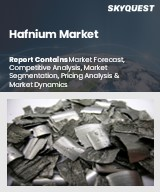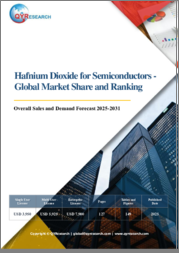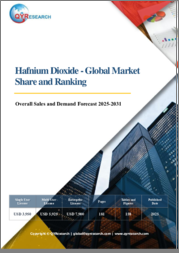
|
시장보고서
상품코드
1780243
하프늄 시장 규모, 점유율, 성장 분석 : 유형별, 등급별 전망, 용도별, 최종사용자별, 지역별 - 산업 예측(2025-2032년)Hafnium Market Size, Share, and Growth Analysis, By Type (Hafnium Metal, Hafnium Oxide), By Grade Outlook (Hafnium 70, Hafnium 75), By Application, By End-user, By Region - Industry Forecast 2025-2032 |
||||||
세계의 하프늄 시장 규모는 2023년에 3억 8,020만 달러로 평가되며, 2024년 4억 377만 달러에서 2032년까지는 6억 5,333만 달러로 성장하며, 예측 기간(2025-2032년)의 CAGR은 6.2%로 성장할 전망입니다.
하프늄 시장은 고온 초합금, 원자로용 제어봉, 반도체용 게이트 산화물에 대한 사용 증가에 힘입어 괄목할 만한 성장세를 보이고 있습니다. 정밀 전자기기, 소형 원자로, 항공우주용 합금에 대한 수요는 하프늄이 미래 지향적인 분야에 필수적인 부품임을 입증하고 있습니다. 또한 AI를 활용한 품질관리 시스템의 발전으로 하프늄 산화물 생산이 개선되고, 고유전율 용도에서 오염을 최소화하여 첨단 로직 칩 및 핵 등급 어셈블리에서 하프늄의 중요성이 증가하고 있습니다. 또한 유럽과 아시아의 국방 및 에너지 기관들의 전략적 비축 노력은 공급 탄력성을 강화하고 산업 확장을 더욱 촉진하며 하프늄을 다양한 혁신 기술에 필수적인 요소로 자리매김하고 있습니다.
목차
서론
- 조사의 목적
- 조사 범위
- 정의
조사 방법
- 정보 조달
- 2차와 1차 데이터 방법
- 시장 규모 예측
- 시장의 전제조건과 제한
개요
- 세계 시장 전망
- 공급과 수요 동향 분석
- 부문별 기회 분석
시장 역학과 전망
- 시장 개요
- 시장 규모
- 시장 역학
- 촉진요인과 기회
- 억제요인과 과제
- Porter의 산업 분석
주요 시장 인사이트
- 주요 성공 요인
- 경쟁의 정도
- 주요 투자 기회
- 시장 에코시스템
- 시장의 매력 지수(2024년)
- PESTEL 분석
- 거시경제 지표
- 밸류체인 분석
- 가격 분석
- 사례 연구
세계의 하프늄 시장 규모 : 유형별·CAGR(2025-2032년)
- 시장 개요
- 하프늄 금속
- 하프늄 산화물
- 하프늄 탄화물
- 기타
세계의 하프늄 시장 규모 : 등급별 전망·CAGR(2025-2032년)
- 시장 개요
- 하프늄 70
- 하프늄 75
- 하프늄 80
세계의 하프늄 시장 규모 : 용도별·CAGR(2025-2032년)
- 시장 개요
- 슈퍼 합금
- 광학 코팅
- 핵
- 플라즈마 절단
- 기타
세계의 하프늄 시장 규모 : 최종사용자별·CAGR(2025-2032년)
- 시장 개요
- 항공우주·방위
- 원자력 에너지
- 일렉트로닉스·반도체
- 기타
세계의 하프늄 시장 규모·CAGR(2025-2032년)
- 북미
- 미국
- 캐나다
- 유럽
- 독일
- 스페인
- 프랑스
- 영국
- 이탈리아
- 기타 유럽 지역
- 아시아태평양
- 중국
- 인도
- 일본
- 한국
- 기타 아시아태평양
- 라틴아메리카
- 브라질
- 기타 라틴아메리카 지역
- 중동 및 아프리카
- GCC 국가
- 남아프리카공화국
- 기타 중동 및 아프리카
경쟁 정보
- 상위 5사의 비교
- 주요 기업의 시장 포지셔닝(2024년)
- 주요 시장 기업이 채택한 전략
- 최근 시장 동향
- 기업의 시장 점유율 분석(2024년)
- 주요 기업의 기업 개요
- 기업의 상세
- 제품 포트폴리오 분석
- 기업의 부문별 점유율 분석
- 매출의 전년대비 비교(2022-2024년)
주요 기업 개요
- Materion
- Western Zirconium
- ATI Inc.
- Element Six
- TOSOH
- Alkane Resources
- Treibacher Industrie
- Thermo Fisher Scientific
- American Elements
- Global Advanced Metals
결론과 제안
KSA 25.08.07Global Hafnium Market size was valued at USD 380.2 million in 2023 and is poised to grow from USD 403.77 million in 2024 to USD 653.33 million by 2032, growing at a CAGR of 6.2% during the forecast period (2025-2032).
The hafnium market is witnessing significant growth, fueled by its rising utilization in high-temperature superalloys, control rods for nuclear reactors, and gate oxides in semiconductor applications. The demand for precision electronics, compact reactors, and aerospace-grade alloys reinforces hafnium's status as a vital component for future-oriented sectors. Moreover, advancements in AI-driven quality control systems have improved the production of hafnium oxide, minimizing contamination in high-k dielectric applications, which enhances hafnium's importance in advanced logic chips and nuclear-grade assemblies. Additionally, strategic stockpiling initiatives by defense and energy agencies across Europe and Asia are bolstering supply resilience, further driving industrial expansion and positioning hafnium as an essential element in various innovative technologies.
Top-down and bottom-up approaches were used to estimate and validate the size of the Global Hafnium market and to estimate the size of various other dependent submarkets. The research methodology used to estimate the market size includes the following details: The key players in the market were identified through secondary research, and their market shares in the respective regions were determined through primary and secondary research. This entire procedure includes the study of the annual and financial reports of the top market players and extensive interviews for key insights from industry leaders such as CEOs, VPs, directors, and marketing executives. All percentage shares split, and breakdowns were determined using secondary sources and verified through Primary sources. All possible parameters that affect the markets covered in this research study have been accounted for, viewed in extensive detail, verified through primary research, and analyzed to get the final quantitative and qualitative data.
Global Hafnium Market Segments Analysis
Global Hafnium Market is segmented by Type, Grade Outlook, Application, End-user and region. Based on Type, the market is segmented into Hafnium Metal, Hafnium Oxide, Hafnium Carbide and Others. Based on Grade Outlook, the market is segmented into Hafnium 70, Hafnium 75 and Hafnium 80. Based on Application, the market is segmented into Super Alloy, Optical Coating, Nuclear, Plasma Cutting and Others. Based on End-user, the market is segmented into Aerospace & Defence, Nuclear Energy, Electronics and Semiconductors and Others. Based on region, the market is segmented into North America, Europe, Asia Pacific, Latin America and Middle East & Africa.
Driver of the Global Hafnium Market
The global hafnium market is experiencing significant growth, primarily driven by its rising demand in various applications. Hafnium is increasingly recognized for its properties as a corrosion-resistant and heat-resistant pigment, making it essential in the production of high-temperature refractory bricks and metallurgical coatings. Notably, manufacturers of stainless steel and superalloys in Asia and the Western regions are ramping up their production, which directly enhances the usage of hafnium in superalloys and low-carbon stainless steel. Furthermore, its applications in coatings for oxygen lances, furnace linings, and welding electrodes are contributing to substantial advancements in construction-grade metallurgy. This surge in demand is particularly notable in countries like India, Japan, and China, where domestic alloy production is expanding due to growing investments geared towards energy transition initiatives.
Restraints in the Global Hafnium Market
The global hafnium market faces significant challenges due to stringent environmental regulations surrounding mining, processing, and waste disposal. The extraction of hafnium through chromite ore mining is heavily energy-dependent and raises concerns related to soil degradation, water pollution, and heavy metal exposure. Increased governmental oversight has led many countries to impose stricter rules on effluent treatment and waste disposal, resulting in higher compliance costs. This situation particularly impacts small-scale metallurgical and pigment producers in developing economies, hindering their ability to compete and ultimately stifling overall market growth. Addressing these environmental concerns while balancing economic viability remains a critical challenge for the industry.
Market Trends of the Global Hafnium Market
The global hafnium market is experiencing a significant trend towards technological innovation, highlighted by the introduction of AI-enhanced hafnium-based semiconducting films by Applied Materials in 2024. This advanced deposition platform targets the demanding specifications of future 3nm logic nodes, emphasizing precision automation and defect-free processes in semiconductor production. As the industry pivots towards high-k dielectric integration with reduced line edge roughness, the growing adoption of AI-driven fabrication technologies signifies a pivotal shift in manufacturing efficiency and product quality. This evolution not only boosts hafnium demand but also positions it as a critical material in the semiconductor landscape moving forward.
Table of Contents
Introduction
- Objectives of the Study
- Scope of the Report
- Definitions
Research Methodology
- Information Procurement
- Secondary & Primary Data Methods
- Market Size Estimation
- Market Assumptions & Limitations
Executive Summary
- Global Market Outlook
- Supply & Demand Trend Analysis
- Segmental Opportunity Analysis
Market Dynamics & Outlook
- Market Overview
- Market Size
- Market Dynamics
- Drivers & Opportunities
- Restraints & Challenges
- Porters Analysis
- Competitive rivalry
- Threat of substitute
- Bargaining power of buyers
- Threat of new entrants
- Bargaining power of suppliers
Key Market Insights
- Key Success Factors
- Degree of Competition
- Top Investment Pockets
- Market Ecosystem
- Market Attractiveness Index, 2024
- PESTEL Analysis
- Macro-Economic Indicators
- Value Chain Analysis
- Pricing Analysis
- Case Studies
Global Hafnium Market Size by Type & CAGR (2025-2032)
- Market Overview
- Hafnium Metal
- Hafnium Oxide
- Hafnium Carbide
- Others
Global Hafnium Market Size by Grade Outlook & CAGR (2025-2032)
- Market Overview
- Hafnium 70
- Hafnium 75
- Hafnium 80
Global Hafnium Market Size by Application & CAGR (2025-2032)
- Market Overview
- Super Alloy
- Optical Coating
- Nuclear
- Plasma Cutting
- Others
Global Hafnium Market Size by End-user & CAGR (2025-2032)
- Market Overview
- Aerospace & Defence
- Nuclear Energy
- Electronics and Semiconductors
- Others
Global Hafnium Market Size & CAGR (2025-2032)
- North America (Type, Grade Outlook, Application, End-user)
- US
- Canada
- Europe (Type, Grade Outlook, Application, End-user)
- Germany
- Spain
- France
- UK
- Italy
- Rest of Europe
- Asia Pacific (Type, Grade Outlook, Application, End-user)
- China
- India
- Japan
- South Korea
- Rest of Asia-Pacific
- Latin America (Type, Grade Outlook, Application, End-user)
- Brazil
- Rest of Latin America
- Middle East & Africa (Type, Grade Outlook, Application, End-user)
- GCC Countries
- South Africa
- Rest of Middle East & Africa
Competitive Intelligence
- Top 5 Player Comparison
- Market Positioning of Key Players, 2024
- Strategies Adopted by Key Market Players
- Recent Developments in the Market
- Company Market Share Analysis, 2024
- Company Profiles of All Key Players
- Company Details
- Product Portfolio Analysis
- Company's Segmental Share Analysis
- Revenue Y-O-Y Comparison (2022-2024)
Key Company Profiles
- Materion
- Company Overview
- Business Segment Overview
- Financial Updates
- Key Developments
- Western Zirconium
- Company Overview
- Business Segment Overview
- Financial Updates
- Key Developments
- ATI Inc.
- Company Overview
- Business Segment Overview
- Financial Updates
- Key Developments
- Element Six
- Company Overview
- Business Segment Overview
- Financial Updates
- Key Developments
- TOSOH
- Company Overview
- Business Segment Overview
- Financial Updates
- Key Developments
- Alkane Resources
- Company Overview
- Business Segment Overview
- Financial Updates
- Key Developments
- Treibacher Industrie
- Company Overview
- Business Segment Overview
- Financial Updates
- Key Developments
- Thermo Fisher Scientific
- Company Overview
- Business Segment Overview
- Financial Updates
- Key Developments
- American Elements
- Company Overview
- Business Segment Overview
- Financial Updates
- Key Developments
- Global Advanced Metals
- Company Overview
- Business Segment Overview
- Financial Updates
- Key Developments



















